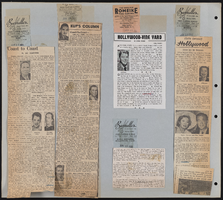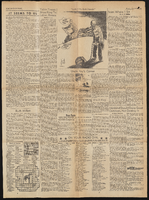Search the Special Collections and Archives Portal
Search Results
Stella Champo Iaconis oral history interviews
Identifier
Abstract
Oral history interview with Stella Champo Iaconis conducted by Kay Long on May 14, 1997, May 21, 1997, May 26, 1997, and September 22, 1997 for the Women's Research Institute of Nevada (WRIN) Las Vegas Women Oral History Project. Iaconis opens her interviews discussing her difficult upbringing and life on a ranch in Las Vegas, Nevada with her dad in the 1910s and 1920s. Iaconis then describes her experiences as a waitress in Las Vegas. As the interviews continue, Iaconis discusses Block 16 and sex work, the Helldorado Days, and life in 1930s Las Vegas. Iaconis ends the interview talking about her father and his career as a miner; her many husbands; and her personal history in Las Vegas.
Archival Collection
Nancy Houssels oral history interviews
Identifier
Abstract
Oral history interviews with Nancy Houssels conducted by Caryll Batt Dziedziak on November 18, 1998, December 07, 1998, and December 14, 1998 for the Women's Research Institute of Nevada (WRIN) Las Vegas Women Oral History Project. Houssels begins her interviews discussing her childhood in California and the influence World War II had on her upbringing. Houssels then talks about her dance training and career including topics on her auditions, her dance partners, and touring Europe in the 1960s. Houssels describes coming to Las Vegas, Nevada in 1968 where she was booked as a dancer in Folies Bergere at the Tropicana Hotel. Houssels then discusses the influences Mormonism and adiago ballet had on her life. Houssels then describes how she co-founded the Nevada Ballet Theatre with Vassili Sulich, performances of the company, their dancers, and community outreach.
Archival Collection
Anna Bailey oral history interview
Identifier
Abstract
Oral history interview with Anna Bailey conducted by Claytee White on March 03, 1997 for the Women's Research Institute of Nevada (WRIN) Las Vegas Women Oral History Project. Bailey opens her interview by describing her early life, family, and dance training. She discusses moving to Los Angeles, California at age fifteen, her first dancing gigs, and touring in London, England. She also talks about her experiences as an African American dancer including issues with segregation while touring in the southern United States. Bailey then discusses her life in Las Vegas, Nevada in the 1950s, and working as a dancer at the Moulin Rouge. She describes the club, the other dancers that performed there, and how the African American community felt when the club closed. Bailey then discusses how her husband and the entertainers Josephine Baker and Frank Sinatra helped integrate Las Vegas. She ends her interview by describing the last hotel she danced at, the Flamingo, where she performed in an integrated dance line.
Archival Collection
Spencer and Georgia Hanna Butterfield Photograph Collection
Identifier
Abstract
The Spencer and Georgia Hanna Butterfield Photograph Collection (approximately 1900-1978) consists of black-and-white photographic prints and negatives of the Hanna and Butterfield families. It also contains images of early and prominent residents of Las Vegas, Nevada such as James Cashman Sr., Las Vegas Chamber of Congress members, Union Pacific Railroad president George Ashby, and many other notable persons from early Las Vegas. The collection also includes photographs taken in Elko County, Nevada, the Hoover Dam, and other Las Vegas area images.
Archival Collection
Claudine Williams Photograph Collection
Identifier
Abstract
The Claudine Williams Photograph Collection (approximately 2007-2009) consists of nine optical disks containing ninety-eight digital surrogate images dating between 1940 and 2000. The images primarily portray Claudine Williams in publicity images for various hotel and casinos Williams and her husband owned alongside prominent individuals, including Dean Martin, Hillary and Bill Clinton, and Robert Reich. Other images depict Williams in her youth and with her family members. Additional materials include images of Williams’ business cards, articles in various Las Vegas and Nevada magazines and newspapers on Williams, and images of properties Williams operated.
Archival Collection
Sook-ja Kim oral history interviews
Identifier
Abstract
Oral history interviews with Sook-ja Kim conducted by Myoung-ja Lee Kwon on February 12, 1996 and April 06, 1996 for the Women's Research Institute of Nevada (WRIN) Las Vegas Women Oral History Project. Kim begins her interview discussing her family's background in singing in Korea and she then transitions to her and her sisters' arrival to Las Vegas, Nevada in 1959. Kim discusses their Las Vegas act, singing rock 'n' roll tunes at the Thunderbird Hotel. Kim goes on to discuss her groups' big break, performing on the Ed Sullivan Show. Kim describes how this event ignited a successful touring period for the sisters and the eventual launching of another group, the Kim Brothers, comprised of Sook-ja Kim's brothers. Kim ends the interview discussing what challenges Koreans face when moving to America and important information she thinks future Korean immigrants should know or consider.
Archival Collection

Interview with Henry Eloy Peluaga, April 22, 2005
Date
Archival Collection
Description
Text

Myron Martin and Don Snyder interviews, November 30, 2017, December 06, 2017, and March 08, 2018: transcript
Date
Archival Collection
Description
Part 1: Interviewed by Stefani Evans. Myron G. Martin, President and CEO, and Donald D. Snyder, Chairman of the Board of Directors, share their memories of the founding of The Smith Center for the Performing Arts from the first non-for-profit foundation formed in 1996. The second iteration led by Snyder in 1999 brought in Martin--former Director of UNLV Performing Arts Center--and created a sustainable business plan for a center for the performing arts that would be accessible geographically and culturally for all segments of Nevada society. Here, Martin and Snyder recall how land, funding, and legislation for The Smith Center depended on the ""power of the project"" and the Snyder-Martin team's ability to overcome skeptics in the public, the Nevada Legislature, the Clark County Commission, the Las Vegas City Council, and the Don Reynolds Foundation. Martin and Snyder satisfied the various requirements for each organization and earned unanimous approval at each stop--in fact, the $50 million donation to The Smith Center was the largest the Don Reynolds Foundation had ever granted largest. That the approvals came on three consecutive days from competing municipal jurisdictions makes the accomplishment even sweeter. Subjects: Las Vegas, NV; Cultural center; Performing arts; The Smith Center for the Performing Arts; The Smith Center; Not-for-profit;; Nevada Legislature; Clark County Commission; Las Vegas City Council; The Don Reynolds Foundation; Fundraising; Planning; Endowment; Part 2: Interviewed by Stefani Evans. Martin, who was the youngest of three boys raised in suburban Houston, Texas, likes to say that in college at the University of North Texas he played for the Atlanta Braves and the Texas Rangers. So he did--as the organist. He earned a Bachelors of Music in piano, organ, and voice and an MBA from Golden Gate University. He came to Las Vegas after a fifteen-year career with the Baldwin Piano Company as executive director of the Liberace Foundation; he later became president of UNLV?s Performing Arts Center and in 1999 he became president of the Las Vegas Performing Arts Center Foundation. Here, Martin and Snyder recall the process whereby they hired architect David Schwarz of Washington, DC, to create The Smith Center's ""timeless, elegant"" look; creating a ""shared vocabulary"" by visiting 14 performing venues in 5 European countries; the City of Las Vegas's RFP that resulted in hiring Whiting-Turner Contracting Company; the exterior art/artists, significance of the bell tower, Founding Fifty(seven), and the ability of the theater to adapt from staging The Book of Mormon to staging a community funeral for two slain police officers. Subjects: The Smith Center; The Smith Center for the Performing Arts; Architecture; Fundraising; Acoustics; Public private partnerships; Request for proposals; Whiting-Turner; Theater Projects Group; vocabulary; Part 3: Interviewed by Stefani Evans. Author Jack Sheehan, joining this third session on The Smith Center in his role as Don Snyder's biographer, explains the way he envisions the place of The Smith Center in the larger context of Las Vegas. Martin and Snyder provide names for the group that grew out of the Call to Action meeting and founded the original Las Vegas Performing Arts Foundation. They share anecdotes of a 2005 trip, wherein they were joined by Las Vegas City Councilman Lawrence Weekly, City of Las Vegas Mayor Oscar Goodman, and consultant to the City of Las Vegas Dan Van Epp to visit City Place and the Kravis Center for Performing Arts in West Palm Beach as an example of a place where a performing arts center was a catalyst for revitalization in an area of underused and underutilized urban land. They discuss opening night, March 10, 2012, /From Dust To Dreams: Opening Night at the Smith Center For The Performing Arts/, which was produced broadcast live on national Public Broadcasting System (PBS) television stations, produced by George Stevens Jr. and directed and produced by Michael Stevens for The Stevens Company; hosted by Neil Patrick Harris; and featuring Jennifer Hudson, Willie Nelson, Merle Haggard, Emmylou Harris, Martina McBride, Carole King, Arturo Sandoval, Joshua Bell, Mavis Staples, Pat Monahan; American Ballet Theater dancers Marcello Gomes and Luciana Paris; also Broadway performers Brian Stokes Mitchell, Laura Osnes, Cheyenne Jackson, Sherie Rene Scott, Montego Glover, and Benjamin Walker. Martin describes how provisions of Nevada SB235--introduced March 6, 2017, signed into law by Governor Bob Sandoval, and became effective October 1, 2017--for the regulation of ticket sales to an athletic contest or live entertainment event affect The Smith Center ticket sales. They talk of providing 3,600 good construction jobs during the recession, of Discovery Childrens Museum, of future development plans for the entire 61-acre Symphony Park parcel, and of a second capital campaign to increase the endowment to $100 million to enable The Smith Center to be economically sustainable.
Text


